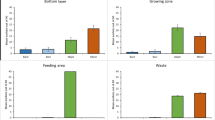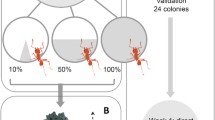Abstract
Seeds of different plant species constitute an alternative but also significant substrate that leaf-cutting ants use to cultivate their fungus garden. However, how they are processed inside the nest and if their use implies differential allocation of worker size classes are still poorly known. Using laboratory colonies of Acromyrmex subterraneus (Forel) as a model, the behaviors related to the processing of three different seeds (sesame, guava, and grape) as fungus substrate were listed. At the same time, we measured how each worker size class contributed to the execution of these behaviors by registering their respective frequency. It was found that medium-sized (1.2 > head width < 1.6 mm) and minimum-sized (head width <1.1 mm) workers assumed the role of incorporation for sesame and grape seeds, respectively. Major-sized workers (head width >1.7 mm) were concentrated on licking and holding guava seeds. Tegument removal was the only task observed that differs between treatment of seeds and treatment of leaves before their incorporation, as described in the literature. It was verified that different species of seeds imply a differential allocation of worker size classes and the inclusion or exclusion of some tasks from the behavioral repertoire. Regardless of the substrate type, leaf-cutting ant workers follow a coordinated and specialized procedure to cultivate the fungus garden but always maintain a high degree of cooperation.
Similar content being viewed by others
References
Anderson C, Franks NR (2001) Teams in animal societies. Behav Ecol 12:534–540
Andrade APP, Forti LC, Moreira AA, Boaretto MAC, Ramos VM, Matos CAO (2002) Behavior of Atta sexdens rubropilosa (Hymenoptera: Formicidae) workers during the preparation of the leaf substrate for symbiont fungus culture. Sociobiology 40:293–306
Augstburger F, Berger J, Chenskowsky U, Heid P, Meilz J, Streit C (2000) Agricultura organica en el tropic y subtrópico: guías de 18 cultivos ajonjolí (sésamo). Asociación Naturland, Gräfelfing, 25 p
Bot ANM, Ortius-Lechner D, Finster K, Maile R, Boomsma JJ (2002) Variable sensitivity of fungi and bacteria to compounds produced by the metapleural glands of leaf-cutting ants. Insect Soc 49:363–370
Camargo RS, Forti LC, Matos CAO, Lopes JF, Andrade APP, Ramos VM (2003) Post-selection and return of foraged material by Acromyrmex subterraneus brunneus (Hymenoptera: Formicidae). Sociobiology 42:93–102
Camargo RS, Forti LC, Lopes JFS, Andrade APP, Ottati ALT (2007) Age polyethism in the leaf-cutting ant Acromyrmex subterraneus brunneus Forel, 1911 (Hymenoptera: Formicidae). J Appl Entomol 131:139–145. doi:10.1111/j.1439-0418.2006.01129.x
Chapman RF (1998) The insects: structure and function. Cambridge University Press, Cambridge, 788 p
Christianini AV, Mayhé-Nunes AJ, Oliveira PS (2012) Exploitation of fallen diaspores by ants: are there ant–plant partner choices? Biotropica 44:360–367. doi:10.1111/j.1744-7429.2011.00822.x
Diniz EA, Bueno OC (2009) Substrate preparation behaviors for the cultivation of the symbiotic fungus in leaf-cutting ants of the genus Atta (Hymenoptera: Formicidae). Sociobiology 53:651–666
Diniz EA, Bueno OC (2010) Evolution of substrate preparation behaviors for cultivation of symbiotic fungus in Attine ants (Hymenoptera: Formicidae). J Insect Behav 23:205–214. doi:10.1007/s10905-010-9207-y
Dunn RR, Parker CR, Gerhaghty M, Sanders NJ (2007) Reproductive phenologies in a diverse temperate ant fauna. Ecol Entomol 32:135–142
Dussutour A, Simpson SJ (2009) Communal nutrition in ants. Curr Biol 19:740–744
Farnese FS, Campos RBF, Fonseca GA (2011) Dispersão de diásporos não mirmecocóricos por formigas: Influência do tipo e abundância do diásporo. Rev Árvore 35:125–130
Forti LC, Camargo RS, Matos CAO, Andrade APP, Lopes JFS (2004) Aloetismo em Acromyrmex subterraneus brunneus Forel (Hymenoptera, Formicidae), durante o forrageamento, cultivo do jardim de fungo e devolução dos materiais forrageados. Rev Bras Entomol 48:59–63
Forti LC, Andrade ML, Andrade APP, Lopes JFS, Ramos VM (2006) Bionomics and identification of Acromyrmex (Hymenoptera: Formicidae) through an illustrated key. Sociobiology 48:1–18
Garrido JL, Rey PJ, Cerdá X, Herrera CM (2002) Geographical variation in diaspore traits of an ant-dispersed plant (Helleborus foetidus): are ant community composition and diaspore traits correlated? J Ecol 90:446–455
Horvitz CC (1981) Analysis of how ant behaviors affect germination in a tropical myrmecochore Calathea microcephala (P. & E.) Koernicke (Marantaceae): microsite selection and aril removal by neotropical ants, Odontomachus, Pachycondyla, and Solenopsis (Formicidae). Oecologia 51:47–52
Howard JJ (1987) Leaf-cutting ant diet selection: the role of nutrients, water, and secondary chemistry. Ecology 68:503–515
Hubbell SP, Wiemer DF, Adejare A (1983) An anti-fungal terpenoid defends a neotropical tree (Hymenaea) against attack by fungus-growing ants (Atta). Oecologia 60:321–327
Kaspari M (1996) Worker size and seed size selection by harvester ants in a neotropical forest. Oecologia 105:397–404
Leal IR, Oliveira PS (1998) Interactions between fungus growing ants (Attini), fruits and seeds in cerrado vegetation in southeast Brazil. Biotropica 30:170–178
Leal IR, Oliveira PS (2000) Foraging ecology of attine ants in a Neotropical savanna: seasonal use of fungal substrate in the cerrado vegetation of Brazil. Insect Soc 47:376–382
Longino JT, Coddington J, Colwell RK (2002) The ant fauna of a tropical rain forest: estimating species richness three different ways. Ecology 83:689–702
Lopes JFS, Camargo RS, Forti LC (2003) Foraging behavior and subtask hierarchical structure in Acromyrmex spp. (Hymenoptera: Formicidae). Sociobiology 42:781–793
Lopes JFS, Forti LC, Camargo RS (2004) The influence of the scout upon the decision-making process of recruited workers in threee Acromyrmex species. Behav Process 67:471–476
Namiki M (1995) The chemistry and physiological functions of sesame. Food Rev Int 11:201–239. doi:10.1080/87559129509541043
Pagnocca FC, Silva OA, Hebling-Beraldo MJ, Bueno OC, Fernandes JB, Vieira PC (1990) Toxicity of sesame extracts to the symbiotic fungus of leaf-cutting ants. Bull Entomol Res 80:349–352
Passos L, Ferreira SO (1996) Ant dispersal of Croton priscus (Euphorbiaceae) seeds in a tropical semideciduous forest in southeastern Brazil. Biotropica 28:697–700
Passos L, Oliveira PS (2003) Interactions between ants, fruits and seeds in a restinga forest in south-eastern Brazil. J Trop Ecol 19:261–270. doi:10.1017/S0266467403003298
Pereira RC, Della-Lucia TMC (1998) Estimativa populacional em ninhos de Acromyrmex subterraneus Forel, 1893 (Hymenoptera: Formicidae). Rev Ceres 45:573–578
Pfeiffer M, Nais J, Linsenmair KE (2006) Worker size and seed size selection in ‘seed’-collecting ant ensembles (Hymenoptera: Formicidae) in primary rain forests on Borneo. J Trop Ecol 22:685–693. doi:10.1017/S0266467406003622
Pizo MA, Oliveira PS (1998) Interaction between ants and seeds of a nonmyrmechocorous neotropical tree, Cabralea canjerana (Meliaceae), in the Atlantic forest of southeast Brazil. Am J Bot 85:669–674
Pizo MA, Oliveira PS (2000) The use of fruits and seeds by ants in the Atlantic Forest of southeast Brazil. Biotropica 32:851–861. doi:10.1111/j.1744-7429.2000.tb00623.x
Poulsen M, Bot ANM, Nielsen MG, Boomsma JJ (2002) Experimental evidence for the costs and hygienic significance of the antibiotic metapleural gland secretion in leaf-cutting ants. Behav Ecol Sociobiol 52:151–157. doi:10.1007/s00265-002-0489-8
Queiroga VP, Freire RMM, Firmino PT, Marinho DRF, Silva AC, Barbosa WT, Queiroga DAN (2012) Avaliação da qualidade das sementes de gergelim submetidas aos processos de despeliculação manual, físico e mecânico. Rev Bras Prod Agroind 14:307–315
R Development Core Team (2013) R: A language and environment for statistical computing. R Foundation for Statistical Computing, Vienna, Austria. ISBN 3-900051-07-0, URL http://www.R-project.org/ Accessed 24 Jan 2014
Ribeiro SB, Pagnocca FC, Victor SR, Bueno OC, Hebling M Jr, Bacci M Jr, Silva OA, Fernandes JB, Vieira PC, Silva MFGF (1998) Activity of sesame leaf extracts against the symbiotic fungus of Atta sexdens L. An Soc Entomol Bras 27:421–426
Roberts JT, Heithaus ER (1986) Ants rearrange the vertebrate-generated seed shadow of a neotropical fig tree. Ecology 67:1046–1051
Roces F, Lighten JRB (1995) Larger bites of leaf-cutting ants. Nature 373:392. doi:10.1038/373392a0
Rockwood LL (1976) Plant selection and foraging patterns in two species of leaf-cutting ants (Atta). Ecology 57:48–61
Santo MME (2007) Secondary seed dispersal of Ricinus communis Linnaeus (Euphorbiaceae) by ants in secondary growth vegetation in Minas Gerais. Rev Árvore 31:1013–1018
Saverschek N, Herz H, Wagner M, Roces F (2010) Avoiding plants unsuitable for the symbiotic fungus: learning and long-term memory in leaf-cutting ants. Anim Behav 79:689–698. doi:10.1016/j.anbehav.2009.12.021
Schofield RMS, Emmett KD, Niedbala JC, Nesson MH (2011) Leaf-cutter ants with worn mandibles cut half as fast, spend twice the energy, and tend to carry instead of cut. Behav Ecol Sociobiol 65:969–982. doi:10.1007/s00265-010-1098-6
Varela RO, Perera TC (2003) Dispersal of Schinus fasciculatus seeds by the leaf-cutting ant Acromyrmex striatus in a shrubland of the dry Chaco, Argentina. J Trop Ecol 19:91–94
Wilson EO (1980) Caste and division of labor in leaf-cutter ants (Hymenoptera: Formicidae: Atta): I. The overall pattern in A. sexdens. Behav Ecol Sociobiol 7:143–156
Wirth R, Beyschlag W, Ryel RJ, Hölldobler B (1997) Annual foraging of the leaf-cutting ant Atta colombica in a semideciduous rain forest in Panama. J Trop Ecol 13:741–757
Wirth R, Herz H, Ryel RJ, Beyschlag W, Hölldobler B (2003) Herbivory of leaf-cutting ants: a case study on Atta colombica in the tropical rainforest of Panama. Springer, Berlin, 233 p
Acknowledgments
The authors wish to thank CNPq for providing fellowships to IN Hastenreiter, RS Camargo, and TA Sales (301917/2009-4) and financial support to JFS Lopes (grant numbers 307335/2009-7 and 569962/2008-0), and to FAPESP for providing financial support (grants 2007/04010-0 and 2007/07091-0) to LC Forti.
Author information
Authors and Affiliations
Corresponding author
Additional information
Edited by Kleber Del Claro – UFU
Rights and permissions
About this article
Cite this article
Hastenreiter, I.N., Sales, T.A., Camargo, R.S. et al. Use of Seeds as Fungus Garden Substrate Changes the Organization of Labor Among Leaf-Cutting Ant Workers. Neotrop Entomol 44, 351–356 (2015). https://doi.org/10.1007/s13744-015-0299-0
Received:
Accepted:
Published:
Issue Date:
DOI: https://doi.org/10.1007/s13744-015-0299-0




